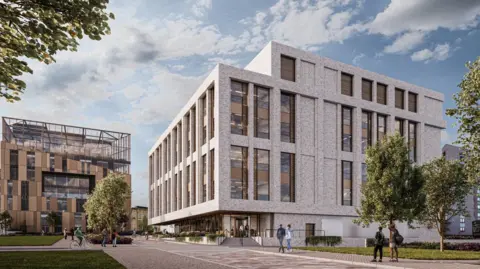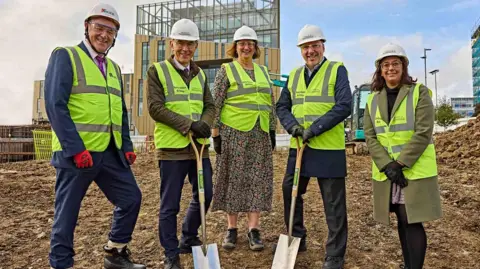University centre named after healthcare pioneer
 University of Huddersfield
University of HuddersfieldBuilding work has started on a health centre named after a "true pioneer" in Huddersfield’s medical history.
The Emily Siddon Building will be the second construction on the University of Huddersfield’s National Health Innovation Campus (NHIC) and is expected to open in December 2025.
It will include a community diagnostic centre (CDC) where patients can receive MRI and CT scans, specialist teaching facilities for healthcare students and a centre for local start-up businesses.
Prof Tim Thornton, the university's deputy vice-chancellor, said the building would be a “home for innovation”.
The facility on Southgate will be adjacent to the Daphne Steele Building, which opened in January and is named after the woman credited as being the "first black matron" in the NHS.
It will be the first CDC on a university campus and the second CDC to be run by Calderdale and Huddersfield NHS Foundation Trust – the first of which opened in Halifax in July.
The building, designed by architects AHR, will include a health and wellbeing innovation centre for local entrepreneurs, supported by the West Yorkshire Combined Authority.
Prof Thornton said: “The Emily Siddon Building will help to enable courses that are vital to meeting the needs of the country's healthcare workforce.
“Being named after Emily Siddon, a true pioneer in healthcare and equality in the Kirklees area, the building encapsulates our ambitions for this next exciting stage in the development of the NHIC.”
 University of Huddersfield
University of HuddersfieldBrendan Brown, chief executive of the area's NHS foundation trust, said the centre would give local patients better access to healthcare.
“Having the new facility on campus will allow us to give greater choice to our patients closer to home, while increasing the number and breadth of tests we can carry out,” he said.
Who was Emily Siddon?
Siddon, who was born in 1844 and died in 1923, lived in the village of Honley.
She was a member of the National Union of Women’s Suffrage Societies, also known as the suffragists, and was voted vice-president of its council in 1907.
According to the University of Huddersfield, she strove to improve healthcare and equality in several roles often reserved for men.
She was an advocate for improving children’s health and involved in the creation of children’s homes, which replaced workhouses for young people.
She was the second woman in the country to be made a justice of the peace - a judicial officer of a lower court - and the only female member on the leadership team for Huddersfield's first infirmary.
Listen to highlights from West Yorkshire on BBC Sounds, catch up with the latest episode of Look North or tell us a story you think we should be covering here.
